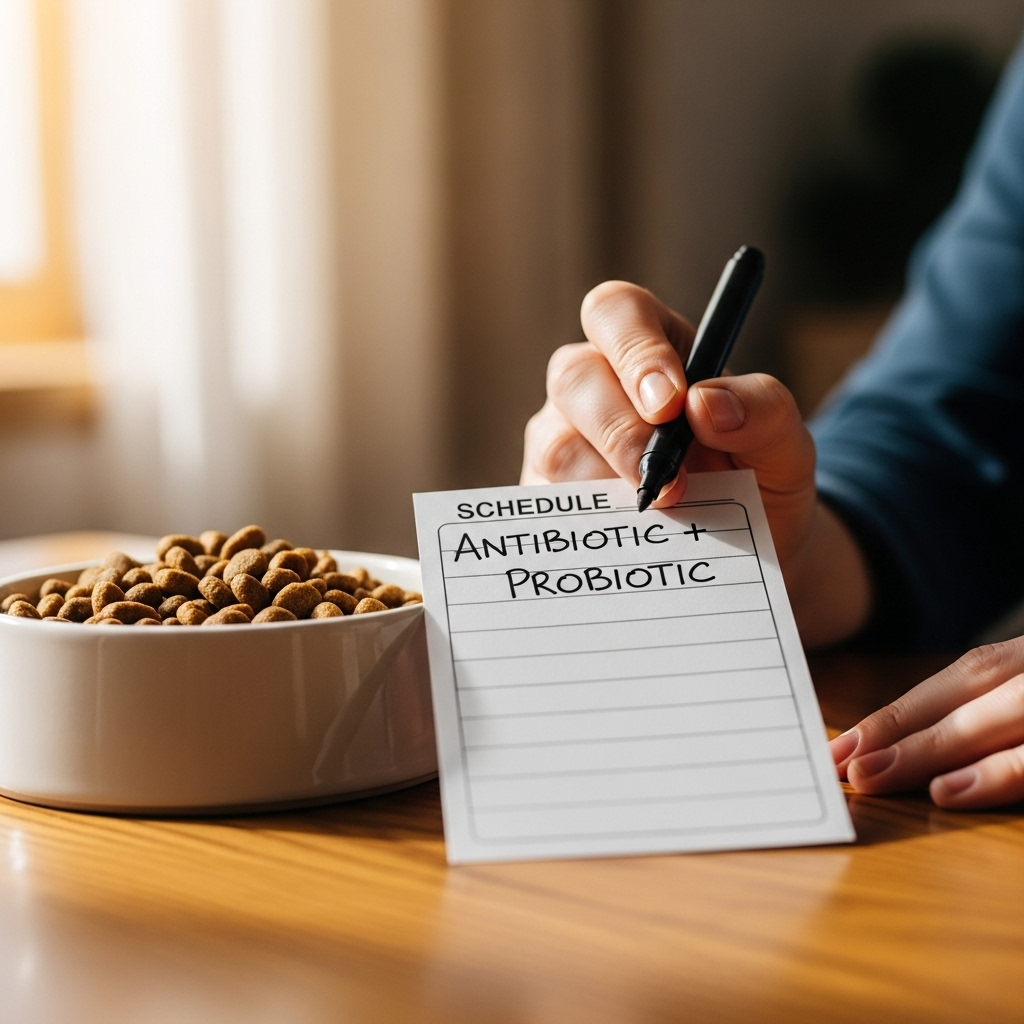How to Use Dog Probiotics During an Antibiotic Course

When your dog needs antibiotics, it’s natural to worry about side effects like upset stomach or diarrhea. Antibiotics can disrupt the balance of beneficial bacteria in the gut — and that’s where probiotics may help. This guide explains what probiotics do, how to choose and time them safely during antibiotic therapy, and what outcomes you can expect. It’s written for pet owners who want practical, evidence-based steps and clear safety guidance.
Why consider probiotics during antibiotics?
Antibiotics kill or inhibit bacteria that cause infection, but they can also reduce populations of helpful gut bacteria. This imbalance (dysbiosis) can lead to antibiotic-associated diarrhea, loose stools, reduced nutrient absorption, and a temporary drop in gut immune support.
- Probiotics are live microorganisms that, when given in adequate amounts, can help restore balance to intestinal flora.
- In dogs, certain probiotic strains have been associated with reduced incidence and severity of antibiotic-associated diarrhea.
- Probiotics can also support digestion and help repopulate the gut after antibiotic treatment ends.
What the research and vets say
Clinical studies in both humans and animals suggest probiotics can lower the risk of antibiotic-associated diarrhea, but effects depend on the strain, dose, and timing. Veterinary guidance typically favors using veterinary-specific probiotic products or human-grade options with strains shown to be safe and effective for dogs.
Key strain examples (commonly used in dogs)
- Enterococcus faecium (selected veterinary strains)
- Lactobacillus species (e.g., L. rhamnosus, L. acidophilus)
- Bifidobacterium species (e.g., B. animalis)
- Spore-forming Bacillus species (in some canine products)
Strain selection matters: benefits are strain-specific, so look for products that list the exact strain and CFUs (colony-forming units).
How to give probiotics while your dog is on antibiotics
- Talk with your veterinarian first. Confirm the recommended probiotic strain and that it’s appropriate for your dog’s health status, age, and current medications.
- Timing: give the probiotic dose at least 2–3 hours after the antibiotic dose. This reduces the chance the antibiotic will inactivate the probiotic organisms.
- Continue probiotics throughout the antibiotic course and for 1–4 weeks after finishing the antibiotic. Many vets recommend at least 1–2 weeks post-course; longer for frequent or long antibiotic use.
- Follow the product’s dosing instructions or your vet’s guidance. Doses are usually based on product CFU and your dog’s size.
- Monitor stool quality and overall behavior. Mild gas or softer stools can occur at first; if severe diarrhea, vomiting, or worsening condition happens, stop and contact your vet.
Formulation and storage
Probiotics come as powders, capsules, chewables, or treats. Some require refrigeration to keep the live organisms viable; others are shelf-stable. Store per the label to maintain potency. If using human probiotic products, choose one with strains and doses appropriate for dogs (your vet can advise).
Choosing a probiotic product
- Prefer products made for dogs or labeled with veterinary strains and CFU counts.
- Look for guaranteed survivability through gastric acid (enteric-coated or strains known to survive stomach acid) when possible.
- Check manufacturing quality: reputable brands provide strain IDs and expiration dates.
- Avoid unproven home remedies — plain yogurt or kefir may contain live cultures but vary widely in strain and potency and can contain too much lactose for some dogs.
Safety, side effects, and who should not use probiotics
Most healthy dogs tolerate probiotics well. Common minor side effects include temporary gas or mild change in stool consistency as the gut flora adjusts.
- Dogs with weakened immune systems, serious systemic illness, or those with central venous catheters should not get probiotics without veterinary approval, as rare infections from probiotic organisms have been reported in immunocompromised patients.
- Puppies, elderly dogs, and dogs on multiple medications should have a veterinary review before starting probiotics.
- If you see severe vomiting, bloody diarrhea, high fever, or rapid deterioration, discontinue the probiotic and contact your veterinarian right away.
| Pros | Cons |
|---|---|
| May reduce antibiotic-associated diarrhea and GI upset | Some products may be ineffective if strain/dose is inappropriate |
| Helps repopulate beneficial gut bacteria after antibiotics | Minor side effects (gas, softer stools) can occur initially |
| Generally safe for healthy dogs when used correctly | Not recommended without vet approval for immunocompromised or critically ill dogs |
Practical tips for pet owners
- Keep a dosing routine—give antibiotics and probiotics at separate times each day.
- Record stool quality and appetite while on antibiotics and probiotics so you can report changes to your vet.
- If your dog refuses a probiotic form (pill, treat, powder), ask your vet about alternatives or mixing options compatible with the product.
- Don’t substitute probiotics for prescribed antibiotic therapy. Probiotics are supportive care, not a replacement for treating bacterial infections.
FAQ
-
Should I start probiotics before my dog begins antibiotics?
It can be helpful to start a probiotic a day or two before antibiotics if recommended by your vet, but the most important factor is consistent timing during the antibiotic course and continuing after it ends.
-
Will the antibiotic kill the probiotic?
Some antibiotic types may reduce the viability of certain probiotic strains. That’s why timing (separating doses by 2–3 hours) is recommended and why strain selection matters.
-
Can I use human probiotics for my dog?
Some human products are suitable, but choose one with documented strains and doses, and check with your veterinarian. Products made for dogs often use strains proven safe in pets.
-
How long should I continue the probiotic after antibiotics?
A common recommendation is to continue for at least 1–2 weeks after the antibiotic course; some cases benefit from 3–4 weeks. Follow your veterinarian’s advice based on your dog’s condition.
Key Takeaways
- Antibiotics can disrupt a dog’s gut bacteria; probiotics can help reduce GI side effects and support recovery.
- Choose strains and products appropriate for dogs and consult your veterinarian before starting.
- Give probiotics 2–3 hours after the antibiotic dose and continue for at least 1–2 weeks after finishing antibiotics.
- Most healthy dogs tolerate probiotics well, but seek vet advice for puppies, elderly dogs, or immunocompromised pets.
- Probiotics support gut health but do not replace prescribed antibiotic treatment.
If you have concerns about side effects or your dog’s response, contact your veterinarian promptly.
Disclaimer: This information is educational and not a substitute for veterinary care. Always consult your veterinarian before starting, stopping, or changing treatments for your pet. Specific product recommendations, dosages, and timing should be individualized by a licensed veterinarian based on your dog’s health history and current medications.

Leave a Reply